
Burgos is a city of Spain located in the autonomous community of Castile and León. It is the capital and most populated municipality of the province of Burgos.

Henry III of Castile, called the Mourner, was the son of John I and Eleanor of Aragon. He succeeded his father as King of Castile in 1390.

María Díaz de Padilla was the mistress of King Peter of Castile.

Juan de Flandes was a Flemish painter active in Spain from 1496 to 1519. His actual name is unknown, although an inscription Juan Astrat on the back of one work suggests a name such as "Jan van der Straat". Jan Sallaert, who became a master in Ghent in 1480, has also been suggested. He worked in the Early Netherlandish style.
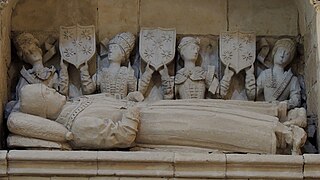
Juan Rodriguez de Fonseca (1451–1524) was a Spanish archbishop, a courtier and bureaucrat, whose position as royal chaplain to Queen Isabella enabled him to become a powerful counsellor to Ferdinand and Isabella, the Catholic Monarchs. He controlled the Casa de Contratación, an agency which managed expeditions to the New World on behalf of the Spanish crown. He later served as the president of the Council of the Indies, when it was founded in 1521. He managed the administration of a number of significant Spanish expeditions including voyages by Christopher Columbus and Magellan's circumnavigation of the earth.
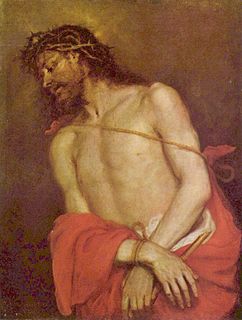
Mateo Cerezo, sometimes referred to as The Younger was a Spanish Baroque painter; known primarily for religious works and still-lifes.
Alfonso Fernández de Palencia, was a Castilian pre-Renaissance historiographer, lexicographer, and humanist.
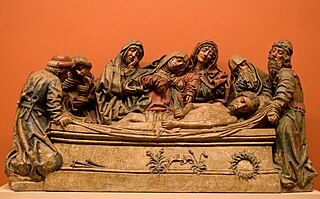
The Sevillian school of sculpture—the tradition of Christian religious sculpture in Seville, Andalusia, Spain—began in the 13th century, formed a clear tradition of its own in the 16th century, and continues into the present. The sculptures are generally worked in wood in a technique known as encarnación.
Gonzalo Pérez 'Gudiel' (1238/9–1299), simply Gonzalo Pérez during his life, and wrongly Gonzalo García Gudiel in later church tradition, was a Castilian prelate and statesman in the service of kings Alfonso X and Sancho IV and Pope Boniface VIII. He was Bishop of Cuenca (1272) and Burgos (1275) and Archbishop of Toledo (1280), the first official Primate of Spain (1285) and finally Cardinal-bishop of Albano (1298) at the curia Romana. His early career was that of an international scholar, before he settled into royal service.
Nicolás de Vergara el Mozo, was a Spanish sculptor, architect, blacksmith and glassmaker. He worked in the Toledo Cathedral, where he was master of works, and in other religious and civil buildings. He was the son of the architect and sculptor Nicolás de Vergara el Viejo and Catalina de Colonia, and brother of Juan de Vergara. He was also the nephew of the master glassmakers Arnao de Vergara and Arnao de Flandes and grandson of Arnao of Flanders the Elder.
Arnao de Vergara was a 16th-century Spanish master glassmaker. Between 1525 and 1536 he produced several windows for Seville Cathedral, many of which survive, before later moving to Granada.

The 1893 Spanish general election was held on Sunday, 5 March and on Sunday, 19 March 1893, to elect the 6th Restoration Cortes of the Kingdom of Spain. All 401 seats in the Congress of Deputies were up for election, as well as 180 of 360 seats in the Senate.

The 1891 Spanish general election was held on Sunday, 1 February and on Sunday, 15 February 1891, to elect the 5th Restoration Cortes of the Kingdom of Spain. All 401 seats in the Congress of Deputies were up for election, as well as 180 of 360 seats in the Senate. The electorate consisted of about 27.3 % of the country's population.

The 1886 Spanish general election was held on Sunday, 4 April and on Sunday, 25 April 1886, to elect the 4th Restoration Cortes of the Kingdom of Spain. All 395 seats in the Congress of Deputies were up for election, as well as 180 of 360 seats in the Senate. The electoral body consisted of about 4.6 % of the country population.

The 1884 Spanish general election was held on Sunday, 27 April and on Thursday, 8 May 1884, to elect the 3rd Restoration Cortes of the Kingdom of Spain. All 393 seats in the Congress of Deputies were up for election, as well as 180 of 360 seats in the Senate.

The 1881 Spanish general election was held on Sunday, 21 August and on Friday, 2 September 1881, to elect the 2nd Restoration Cortes of the Kingdom of Spain. All 392 seats in the Congress of Deputies were up for election, as well as 180 of 360 seats in the Senate.
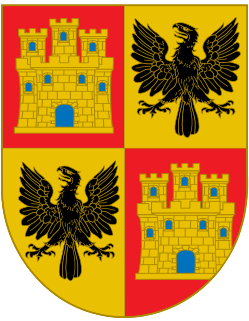
Philip of Castile was an Infante of Castile and son of Ferdinand III, King of Castile and León, and his first queen, Beatrice of Swabia. He was Lord of Valdecorneja, and, according to some sources, Knight of the Order of the Temple, in one of those churches, the Church of Santa María la Blanca in Villalcázar de Sirga, he was buried in a coffin adorned with emblems of the Templars.
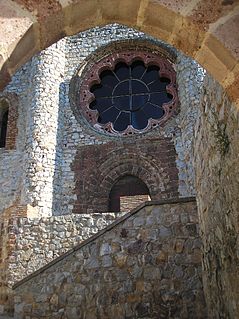
Rodrigo Gutiérrez Girón was a magnate and ricohombre from Palencia who played a key role in the Medieval history of the Iberian Peninsula. He was the first one of his lineage to add Girón to his patronymic. Owner of vast holdings and estates, Rodrigo and his relatives formed one of the most powerful clans in Tierra de Campos since the time of the Banu Gómez.

Diego de la Cruz was a Spanish painter who may have been of Flemish origin. He was active in Burgos and the neighboring region.

José Roca y Ponsa (1852–1938), known also as "Magistral de Sevilla", was a Spanish Roman Catholic priest. In historiography he is known mostly for his role in the 1899 conflict between the archbishops of Toledo and Seville. Catapulted to nationwide notoriety, in the early 1900s he was a point of reference for heated debates on religion and politics; today he is considered a representative of intransigent religious fundamentalism. Roca served as lecturing canon by the cathedrals of Las Palmas (1876-1892) and Seville (1892-1917), animated some diocesan periodicals, and published numerous booklets. He was one of very few nationally recognizable personalities of the Spanish Church who openly and systematically supported the Carlist cause, though he remained sympathetic also towards the Integrist breed of Traditionalism.














